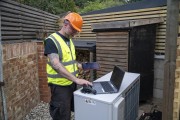We are very quickly learning to construct buildings that produce as much energy as they consume. We’ve seen net-zero buildings and homes in Edmonton, Calgary and Guelph, passive homes in Saskatoon and net-zero laneway homes in Vancouver. That’s great because buildings account for as much as 25 per cent of all carbon emissions in the world.
Vancouver is so confident in super energy efficient design they are implementing a Zero Emissions Building Plan. This will require all new buildings to achieve zero emissions by 2030.
Back to the future
Here’s the problem: if you want to see the future of buildings you need to look to the past. “Around 50 per cent of existing buildings will still be in use by 2050.” This means every inefficient building you build today will still be inefficient 50 years from now. Canada wants an 80 per cent reduction in emissions by 2050, so for existing buildings this means retrofits.
For perspective, this would mean deep retrofits of two per cent of Canada’s building stock per year up to 2050. Deep retrofits usually involve more than 75 per cent energy use reductions. Conversely, shallow retrofits that replace boilers and lighting typically achieve energy savings of 15 per cent.
Deep retrofits: The really, really big elephant in the room
 So why not retrofit every single building in the country by 2050? Sounds crazy, right? Well that’s exactly the goal of EnergieSprong, an idea that sprang from the Netherlands. Translated, EnergieSprong means “energy leap.”
So why not retrofit every single building in the country by 2050? Sounds crazy, right? Well that’s exactly the goal of EnergieSprong, an idea that sprang from the Netherlands. Translated, EnergieSprong means “energy leap.”
“The Netherlands has a goal of retrofitting their entire housing stock, and the affordable housing stock is over 2 million units, to carbon-neutral by 2050,” says Robert Pennings of the City of Vancouver, who previously worked on retrofitting affordable housing in the Netherlands.
“Energiesprong is basically … integrating everything from the financing to the home assessment, to the actual delivery of a net-zero energy retrofit,” says Martha Cambell, a manager in the buildings practice of the Rocky Mountain Institute from Colorado.
Campbell says it’s all about industrializing the process of doing retrofits and making it much more efficient, less custom and lower in cost. She likens the process to what IKEA did for kitchens. We’re talking prefabrication of insulated walls, roofs and materials.
For instance, imagine a truck pulling up loaded up with pre-made walls and a pre-made roof with solar already installed. Presto, in just one week an old energy inefficient home becomes a net-zero home. Everything is packaged together including financing. The retrofit also comes with a 30-year energy performance guarantee.
Turning efficiency into savings
Pennings says the retrofits cost up to $100,000. The idea is to eventually fund the retrofits out of the energy savings, eliminating upfront costs. To sweeten the deal, the energy retrofits are combined with upgrades of kitchens or bathrooms.
“People right now would have a rental bill and a utility bill, and if you go to net zero you should have a utility bill at zero, but they continue to pay the same amount for the rent plus utilities, but the utility part isn’t spent on utilities anymore, it’s spent on financing the retrofitting project,” says Pennings.
Energiesprong has already gone through a pilot phase, retrofitting 500 units. This was part of a larger contract deal between housing associations and industry to do 111,000 retrofits.
The European Commission provided a €3.6 million grant to kick-start retrofit markets and bring the EnergieSprong concept to the UK and France.
Bringing the Sprong to North America
The Rocky Mountain Institute (RMI) is working on a similar concept in the U.S., something they call “Realize.” The idea is to package financing and net-zero retrofits that can be completed in a week to ten days.
RMI even analyzed the net present value of energy savings to determine how much budget is available if you finance projects over 20 to 30 years. In the climatic zone most like Canada RMI estimates there is $20,000 to $45,000 available depending on the present condition of the home and whether you use a 20 year or 30 year time horizon.
This sort of thinking is a big departure from the marketplace’s piecemeal approach. People often replace their siding without a thought given to adding insulation. That could mean a financial net-gain.
Building a low-carbon economy does mean business. For perspective if the Netherlands retrofits all of their 2 million buildings by 2050, that’s $200 billion worth of work for retrofit companies.












